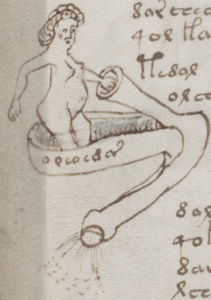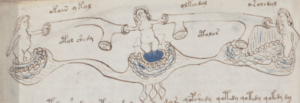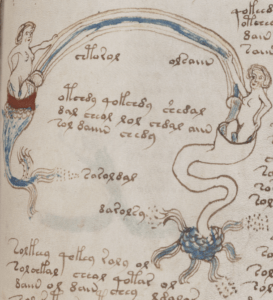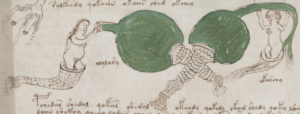And yes, you have me to blame for it.
So here goes…
It all starts in Frascati…
Today’s story begins in the Voynich Centenary Conference back in 2012, with – as I recall – a bunch of Voynicheros crowding around my Jean-Claude Gawsewitch Voynich Manuscript photo-facsimile. With the pages turned to some of the Q13A (medical) pages, Rene Zandbergen remarked that some of the pictures there looked eerily like slightly-disguised medical drawings.
The two diagrams I specifically remember Rene mentioning that day were (a) the “intestines” one:
And… (b) well, this piece of the male anatomy (which nobody can deny has a tube running through it):
Rene himself didn’t claim to have been the first to point out these similarities, but rather said that he had heard them mentioned many years before. As normal, a diligent trawl of the old Voynich mailing list archives would probably reveal more lineage (but it’s not hugely important for the purposes of this post).
Also, as I’m sure many (if not most) Cipher Mysteries readers know, countless Voynich theories have been constructed around the notion that Q13 (Quire 13) has some kind of connection with the female reproductive system, in particular this gloriously mad drawing, with all its oddly misplaced frilly wolkenbanden:
A few pages further on, there’s also a curious pulsating blue brain thing (I have no idea what this means, and I don’t know if anyone has yet looked for visual parallels for it in 15th century manuscripts, perhaps it’s the kind of thing Koen Gheuens would like to take a stab at?):
But you mentioned “testicles”, right?
I did. And so (at last) here’s the specific Voynich image from Q13 that I’m wondering about.
Putting aside the whole ‘nymph’ issue to one side, what – you might reasonably ask – has got into me to wonder if this specific veiled drawing somehow represents a gigantic pair of testicles?
Benedetto Reguardati
A few posts back, I gave a list of authors who wrote small works on thermal baths in the first half (or so) of the fifteenth century. One of those authors was Benedetto Reguardati, a doctor who spent many years attending to the newly-installed Sforza Duke’s family in Milan (and environs).
He wrote a number of small treatises, including a pharmacopoeia that can be found in Firenze, Biblioteca Riccardiana, MS Ricc. 818. This commences (on fol. 2r) with:
Emplastrum optimum ad inflationem testiculorum…
i.e. “the best plaster [normally a paste or salve applied to the skin on a piece of linen or leather] for swollen testicles…“
Sadly, I don’t have access to a transcript of Reguardati’s pharmacopeia (merely its incipit), so don’t know how this continues. Obviously this would be a prime research target for anyone who wants to chase after 15th century recipes for enlarged testicles.
Medieval Writings on Testicles
(By which I don’t actually mean tattoos.)
Though I haven’t yet stumbled upon a literature specifically covering medieval recipes for testicular complaints, it would perhaps be unwise to assume such a niche thing doesn’t exist. Even a fairly cursory search revealed that most testicle-related medical mishaps and scenarios were written about in the Middle Ages.
For example, Arnald of Villanova wrote about testicular hernias; Thorndike (1936) mentions a medical “Experimenta” found in “fols. gr, col. i-gv, col. 2 (older numbering, 1-7) of Vatic. Palat. lat. 1174, a vellum ms of the late thirteenth or early fourteenth century with alternating red and blue initials“, that has a section name “Ad tumorem testiculorum”. Similarly, Simon of Genoa discussed testicular abscesses in his medical dictionary.
John Bradmore also included several brief sections on testicular complaints in his “Philomena” (see Lang 1998):
- 70v 40 de Apostematibus Testiculorum
- 71r 41 de Apostemate hernia Aquosa testiculorum
- 72r 42 de Apostemate hernia ventosa testiculorum
- 73r 43 de (Apostemate) hernia Carnosa et varicosa testiculorum
- 73r 44 De Apostemate hernia humorali testiculorum
Also: p.196 of this book mentions Bodleian MS Selden B35 (circa 1465) as listing “Ydicelidos” = “i. habens testiculos inflatos”, with a footnote mentioning Simon of Genoa’s “Clavis Sanationis”: “Hydrocelici vel ut grecus ydrokilis, dicuntur qui aquam habent circa testiculos in oscum”.
So I think it should hardly be a surprise to find Reguardati writing about salves for swollen testicles. But it turns out that he was far from the only one.
Medieval Swollen Testicles
However, what did surprise me was that I was able to find a good number of different medieval recipes for swollen testicles.
Egritudines Tocius Corporis, written by a physician names Copho in the second half of the 11th century, includes the following section:
De inflatione testiculorum — Ad inflationem testiculorum sine materia, interiora labarum trita optime coquas, et ut comeduntur calida superponus; vel, quod melius est, galbanum in vino coque et cola et in colatura spongiam marinam diu bullias et superponas; vel ebuli seu sambuci summitates diu in vino bullias, et postea cum axungia teras, et hoc totum super testiculos ponas. Si autem maxima duricia sit in testiculis duas pelliculas incide et in tercia stamina pone, et tam diu teneat durice materia que duriciem operatur recedut.
According to Monica H. Green, four versions of the Trotula include an extra section “Ad inflatione testiculorum”:
- 34: Harley 3407
- 70: Digby 29
- 74: Wood empt. 15 (SC 8603)
- 80: New College, 171
I don’t have access to the full text of this section, but it begins:
Ad testiculos inflatos fomentum, accipe maluam, absinthium, uerbenam, bismaluam, cassillaginem, arthimesiam, caules.
13th century Portuguese physician Pedro Hispano’s (Petrus Hispanus) Liber de conservanda sanitate (book by Maria Helena da Rocha Pereira (1973), p.233) has a Chapter XXXV, “De inflatione testium”:
- Si testes inflentur, farina fabarum distemperata cum suco ebuli et oleo communi statim inflationem soluit. Dyascorides.
- Item idem faciunt folia ebuli uel parietarie torrefacta.
- Item idem faciunt folia ebuli et sambuci. Hoc ego.
- Item fimus caprinus cum uino solutus omnem tumerm soluit, Kyrannus.
- Item folia et semen iusquiama trita cum uino et emplastrata omnem tumorem soluit. Macer.
- Item betonica trita et cocta in uino et apposita dolorem et tumorem aufert testiculorum. Dyascorides.
(Note that da Rocha Pereira also includes a quite different version of that same basic chapter in a footnote.)
From Guillem de Béziers (fl. ~1300), we have another recipe “Contra inflationem testiculorum” (on. p.27):
Item. Contra inflationem testiculorum. Fiat primo subfumigium de aqua calida ad apertionem pororum et postea immittatur agrippa, deinde fiat emplastrum de fimo caprino et sepo arietino et thure, et ad ulti[mu]m minutionem vene sophene fac aperire interiori et sic multi curati sunt.
“Three Receptaria from Medieval England” (Hunt & Benskin) includes a couple of items:
- p.26: [207]: Uncore ad inflacionem testiculorum: Recipe malvam, artemisiam, jusquiamum, et caules veteres. Et si non potes habere hec omnia, accipoantur absinthium et malve tantum, et decoquantur et in illa decoctione epithimentur testiculi.
- p.27: [210]: Item paritoria frixa in patella et testiculis superposita removet inflationem testiculorum.
Thoughts, Nick?
Books on baths and medicine were often bound together, so suggesting that the Voynich Manuscript’s Q13 might well contain both balneological and medical bifolios should cause no great tremors. And indeed the bifolios do – as Glen Claston pointed out many years ago – seem to be thematically divided between balneo and medical (in some way).
If you accept this is right, then the idea that a late medieval medical book like this might contain a short section on swollen testicles is surely not a huge stretch, given the number of different sources listed above that contain recipes or treatments for the same.
Might one of these recipes – or something very much like them – be the plaintext for some of the text on f83v? It’s a pretty good challenge, and definitely not a load of balls. 😉





Nick, how about a pair of eyeballs rather?
Green means filled with liquid. And light is passing through pupils.
If you’re looking for alternatives, how about the detail from f.83v as an explanation of rains, but where the Greek and Roman tradition might show the outpouring from an urn or a jug, this comes from a place where the calabash was commonly used to hold liquids? During the medieval centuries this wasn’t only commonplace in Africa, but also in southern Arabia and elsewhere.
I’d think it worth looking into – and also whether the diagram mightn’t be describing the two phases of the monsoon year, one phase of which opposes the other (so to speak). Haven’t looked into that in any detail though, so it’s just a thought.
Nick, your ideas about the Voynich Manuscript illustrations are getting more and more interesting. Here is my idea for your revelations. Regards.
https://fb.watch/7YD3_Udozn/
Testicles? What a wretched conjecture! Actually these round gizmos are meant to create weather (wind, rain, snow) so I call them weatherbags. These two naked ladies are holding weatherbags over their heads not testicles! P.S. Nick, did it ever occur to you that “Mrs Currier B” (=Scribe 2) could have drawn herself in Quire 13?
Nuts!…I’m quite convinced that in f83v, what we’re seeing is a pretty accurate looking diagram of a fine pair of overloaded chloroplast organelles cells, they being part of the C14 conversion path that nobody really cared to learn about in biology class at school. These days better known as the Calvin cycle, it’s all ado about plant & (some) algae cells that be the site of photosynthesis, a wonderful trick of nature whereby solar is converted into energy needed to facilitate growth. There is no way known that science could have conceived this miracle, let alone been able to create an accurate stylised sketch, such as that that depicted circa 1404/32 or up intil the 19th or even 20th century, …So I surely must mistaken right?…like hell I am! and I invite Voynicheros to check out ‘chloroplasts or organelles’ online and see for yourselves that it’s not a load of bollocks.
The goolies also look very much like Finger Limes, especially with the oozing and the offset stalk end. That would render VM to be of Native Australian origin though not in conflict with Greg’s dating assertions.
Sorry, I think the interpretation as testicles is a bit far-fetched. I see here rather a distillation ( f83v ). It could be an early representation in the style of the ” Liber de Arte Distillandi”.
https://www.digitale-sammlungen.de/de/view/bsb10197475?page=3
Entomologically speaking, it’s an interesting exercise to witness a mature Australian Channel-bill nest so successfully so far from its natural habitat ..
My God Curruthers, Peteb’s on the mark. Nothing to do with testicles at all, the gonad imposters are likely to be a pair of art student Maggie Taylor’s cuckoo eggs.
bi3mw: well, that’s a pretty reasonable guess, but it would be much more noteworthy if you were able to dig up manuscript examples.
Maxim: it may well be a wretched conjecture, but it is at least a wretched conjecture backed up by references to a load of actual medieval manuscripts describing salves for the same medical condition.
Which would seem to make it a better wretched conjecture than your weatherbags, alas.
Grzegorz Ostrowski: 7:15? Blimey!
Diane O’Donovan: there are indeed many possibilities here, but few of them seem to have been given much attention. I just wanted to be stake my claim to the world’s first (and probably last) ever swollen testicle decryption. 😉
Anton Alipov: I’m still really in two minds as to whether we can read anything into the green colour that appears in Q13.
I can see one factor favourable to this theory and one factor unfavourable to this theory. The unfavourable one is those protruding wolkenbanden: I do not get what they have to do with testicles, swollen or not. The favourable one is the galore of naughty jokes that could arise from this story.
However I do not think that medical stuff fits with the tone of the Voynich Manuscript. Judging from the pictures, the contents must be nothing less than crazy babbling. If anything, there is some alchemical-astrological interpretation of human organs: intestines-earth, very big tube-water (or even fire, if the Voynich author is a quite self-confident guy), eyes-air (or light, that is fire, if those wolkenbanden are rays of light). I do not know what element the swollen testicles could be.
From memory, the image from f77v that is shown second above was first suggested by Jacques Guy to represent what it may seem to look like. At the time, I was not convinced… It became more plausible to me when I saw the text in the “Balneis” referring to the water of the baths of St(?) Peter. It refers to kidneys and kidney stones (third image above), washing the intestines (first image above), and having dust in one’s urine (second image above).
This would all be achieved / improved by drinking this water.
Sure don’t look likeany kidney sets I ever came across. Wrong shape, wrong ins’n out pipes and the wrong flammin colour for starters. Home grown Aussie lad like Jack musta been on a bender before he came up with this doosie….Haven’t heard from him lately and he doesn’t show up at findagrave Australia, what gives?
Rene, your way of interpreting f77v is unfortunately devoid of logic and elementary medical knowledge – bowel knocking is harmful to the body.
https://www.hizy.net/archives/is-washing-intestines-more-important-than-washing-face-no-dont-mess-around/
In my opinion, f77v encodes knowledge about the female reproductive system and other organs.
From the top:
1. Uterine tubes, Ovaries, Uterus, Vagina.
Left: 2. Pubic bone. 3. Vaginal opening.
Right: 4. Rectum. 5. Urinary bladder.
Grzegorz, what I wrote is what the poem says. It may not coincide with modern medical opinion, but at least it fits with the time when the MS was written.
Rene, Ok, I’m not going to argue about the details on this – I know you want to get out of the situation somehow sensibly. What I mean is a much more important thing, namely that the part of the Voynich Manuscript, which is commonly known and described as a biological section, is also trying to be described as balneological. In my opinion, this is completely nonsensical, for basic reasons, for which I gave an example in the form of my interpretation of f77v.
Well, the biological section is entirely devoted to human anatomy, as indicated by the drawings on the individual pages of the Manuscript. I will only add that each folio separately encodes information about other parts – elements of this anatomy.
Grzegorz Ostrowski: as I mentioned early on in the post, Glen Claston pointed out many years ago that Q13’s bifolios were divided between balneo (bathing) bifolios and (what he called ‘Galenical’) medical bifolios, and called the two groups Q13B and Q13A respectively. So if your starting point here (and hence your disagreement with Rene) is your assumption that the entirety of Q13 can only be medical, then you don’t really seem to have been paying sufficient attention.
Might f77v pics actually be an elaborate pipe condenser system, complete with staged collector resevoirs and drainage outlets similar to that still fitted to modern domestic refrigeration systems. If so, those medieval engineers sure knew their stuff; Just look at what they achieved with pre historic self supporting kidney pools and unique obstetric devices….A quite day on the Somerton Beach front looms.
Nick, I would like to say clearly and clearly that I respect your contribution and effort to explain and decode the mystery of the Voynich Manuscript, but as far as the biological section [as well as other others – but this is a separate matter], I stick to my thesis about which I wrote above. I will only add that I have interpreted all the individual folios of this section and there is no room for balneological phantasmagories.
I have read the idea of Glen Claston, as well as your development, however it is a completely wrong idea, because as a starting point for further considerations you took the wrong assumption about:
“a difference in kind between Q13a and Q13b.”
<<>>
https://ciphermysteries.com/2016/03/24/glen-claston-on-quire-13-from-2009
All your subsequent attempts to fit the evidence to this assumption are flawed. I am not going to go into detail about this “balneological” idea of yours because I think this section is entirely devoted to human anatomy. I have given one example.
Who knows, Nick, who knows? Time will tell which of us was right or maybe we were both wrong.
Grzegorz, Western European scholars are unsurpassed in rational thinking and analysis, so I completely trust Glen Claston’s conclusion about the two subsets of Quire 13.
Their weak spot is just an innate inability to detect / recognise foreign cultures (and religions) packed into European wrappings. Give them a book without pictures written in Tagalog and they will decide that it’s some kind of a European book written in an unknown European language, most likely Spanish. 🙂
Here’s a recent example of this: Zandbergen became interested in the Voynich manuscript back in 1995 (sic!), but it wasn’t until 2020 that he realized that the manuscript was not Christian!
As for the balneological part of Quire 13, I have no doubt that the VMs is a family manuscript of a pre-renaissance bath attendant.
Maxim: I think you are misrepresenting both Glen Claston and Rene Zandbergen there. The Voynich Manuscript will doubtless prove everyone wrong in one way or another, that’s the only certainty.
I do not know if any of the participants of this portal will be interested in what I am writing now, but in my intellectual considerations I took as the main mode of action and all the time I stick to everything that Thomas Kuhn has included under the concept of Paradigm.
So just, unfortunately blind imitation and faith of people like Maxim [and also Nick Pelling] not supported by any evidence “Western European scholars are unsurpassed in rational thinking and analysis, so I completely trust Glen Claston’s conclusion about the two subsets of Quire 13. ” – is the main reason everyone follows one infantile statement from Glen Glaston. Like the blind who follow a blind guide.
Maxim – you are blindly following others and you are also a prisoner of the paradigm. Your faith in everything Zandbergen deduced, or Pelling, is childish faith in their achievements – which are just as childishly naive.
I do not want to elaborate on the argumentation regarding the biological section of the Voynich Manuscript because it is completely wrong. Regards.
Grzegorz Ostrowski: I’m not sure that Kuhn had a chapter on flouncing. But maybe he did.
Nick, you’re either kidding me – which shows your rather low sense of chumor, or you’re a little ignorant about Thomas Kuhn’s accomplishments. I have no intention of unproductive deliberation.
Anton Alipov – in my opinion your interpretation of f83v is correct. I agree with you completely – unlike all the rest of the other misinterpretations.
Grzegorz Ostrowski: if it’s any help, I know a great deal about Thomas Kuhn. 🙂
Nick: Cool. As for me, I assume that knowledge does not hurt and I never underestimate any information, even if it is the least important. In this way, I do not limit the field of information in any way and I am not a prisoner of a once formed idea.
Nick Pelling: I took your lead from what I presumed was a timely interlude for a spot of mirth, so responded in kind as did Grzegorz with a bit of his own humour. After the overdone unfunny rickety bridge skit with it’s disaster theme, all went downhill with f83v’s swollen puke green testes and you’re now paying the price. Shows to go that VM difference of opinion is far from fun, it’s deadly serious business, there being no time for jokes as Voynicheros geeks the world over will affirm.
As for me it’s the second-best theory and I would be an even bigger fan of it if I haven’t started to develop my own… having now promising results.
Having seen these two green balls in your thesis I just recalled that I presented a translation of the two Voynich words just next to the beauties on Rich Santacoloma site some months ago. Our (me and my son) alphabet into assumed Aramaic abjad gave us nothing else but these trivial sentences (Voynichese to read from right to left):
the left one (assignment of glyphs to consonants from the right is 9->y, 2->ph, a->m and so on) –
y-ph-m-sh-b-sh-b
yophi masha `abash `eb
Beauty draws out shrivelled green shoots (fresh green)
Then I wrote yaza’ (perspiration). At that time, I confounded ph and z.
and the right –
y-ll-ph-n-ph-h
‘ay ‘alluph naphah
How intimate/tame/docile lifting! (enthusiastic or meant as funny)
I know, it’s underwhelming and banal and I know, it would be a bit more to explain about the translation – we did it on our site (http://enspace.net).
These single words and short sentences from different pages (we translated meanwhile in dozens), which the scribes jotted down to explain the images or to express their feelings, to make a short yoke (like the 2nd sentence here) or to leave a message (in one a scribe left a message, that the shadow ink is about to go out) are a true bonanza.
I admit, it’s not really a support for the testicle theory.